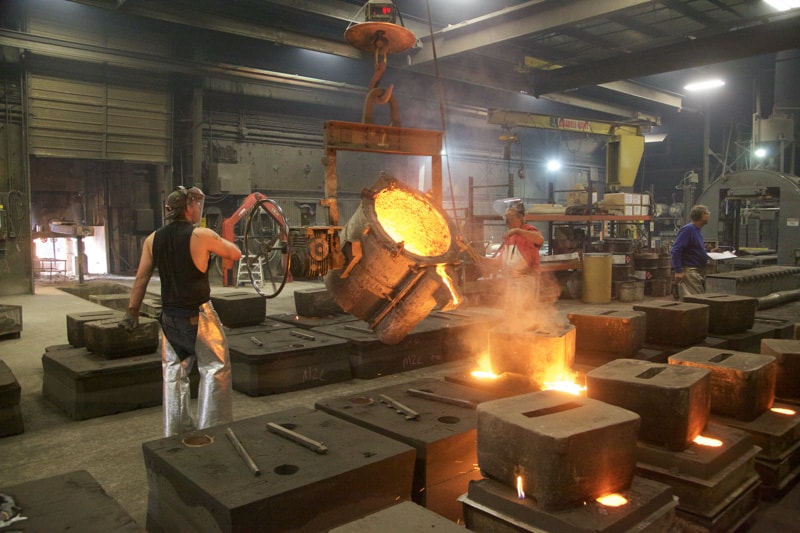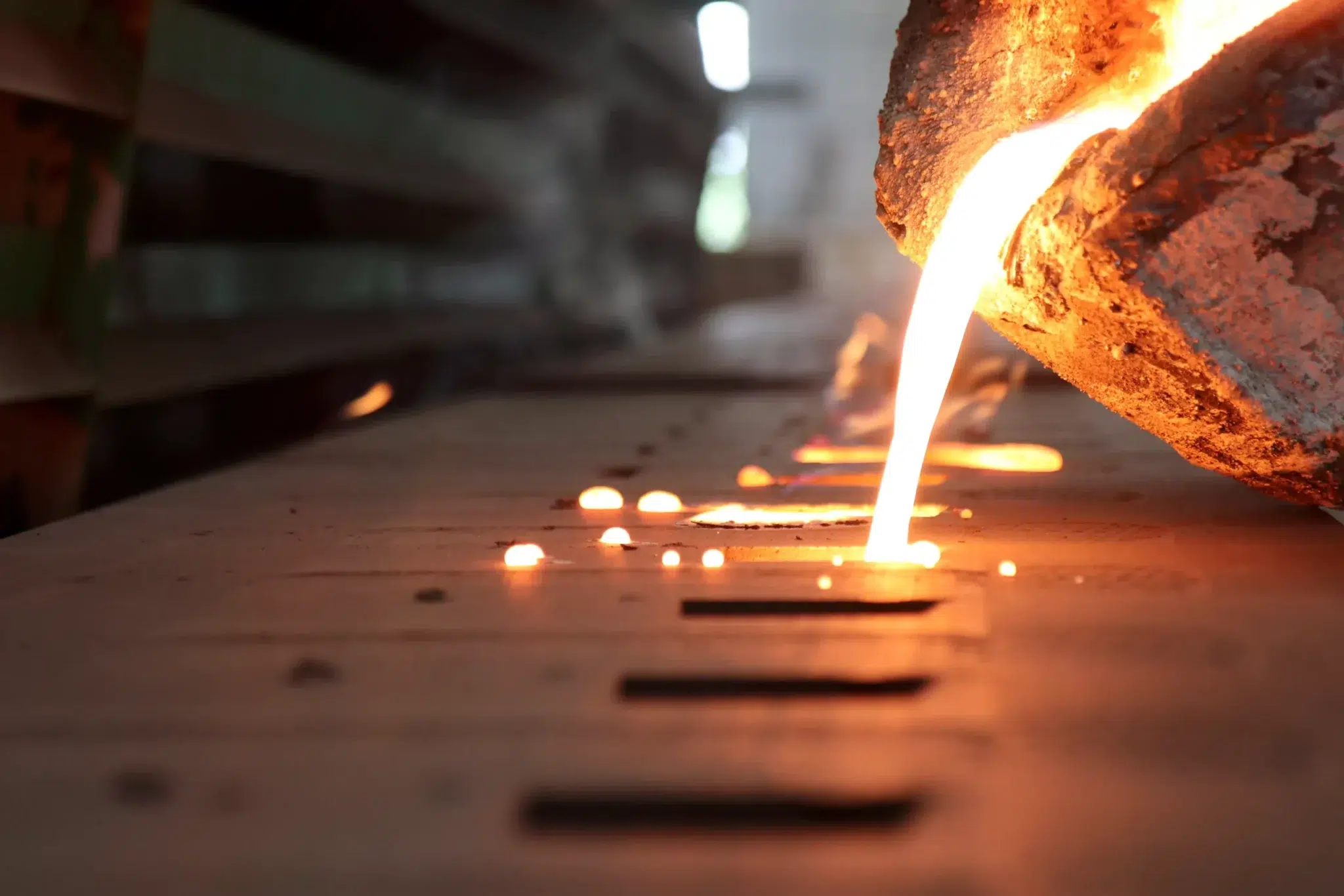Exploring the Latest Robotics Applications in Casting Foundry Operations
Wiki Article
Discover the Innovations and Techniques in the World of Casting Foundry
The Casting Foundry sector is undergoing considerable improvement. Advanced materials and cutting-edge strategies are redefining standard methods. Automation and robotics are improving procedures, while sustainable methods are becoming essential. New mold and mildew layouts and additive manufacturing are using unmatched opportunities. Quality assurance steps are also progressing, guaranteeing dependability in manufacturing. As these fads continue to shape the future of spreading, one should take into consideration just how they will certainly influence the industry overall.The Role of Advanced Materials in Casting
Advanced materials play a vital function in improving the performance and quality of casting processes. They add to boosted thermal stability, lowered shrinking, and increased resilience of cast items. Technologies such as advanced ceramics and composite products offer higher resistance to thermal and mechanical tensions, making it possible for the production of elaborate styles with superior surface area coatings. These products also facilitate better mold and core production, leading to decreased flaws and boosted dimensional accuracy.The usage of alloys with customized residential or commercial properties permits for enhanced performance in particular applications, such as aerospace and vehicle sectors. As foundries embrace advanced materials, they can achieve greater energy performance and lower waste generation, straightening with sustainability goals. The combination of these materials not just streamlines manufacturing but additionally boosts the general competition of Foundry operations in a swiftly developing market, noting a critical shift in typical Casting approaches.
Automation and Robotics in Foundry Operations
Automation and robotics are transforming Foundry operations by improving efficiency and accuracy. These innovations enhance molding procedures, decreasing labor costs and decreasing human error. Therefore, producers are significantly taking on automated systems to boost manufacturing abilities and fulfill rising need.Benefits of Automation
The integration of automation and robotics right into Foundry operations has actually changed traditional production techniques, generating substantial benefits. Enhanced efficiency ranks among the primary advantages, as automated systems operate constantly, lowering cycle times and increasing output. Automation boosts precision and consistency in casting procedures, decreasing defects and guaranteeing greater quality items. (Casting Foundry)Price savings additionally arise from minimized labor expenses and reduced product waste, permitting a lot more efficient source usage. Security is an additional important benefit; automation decreases the risk of human injury by taking care of unsafe jobs. Furthermore, real-time tracking abilities enable much better data collection and evaluation, facilitating notified decision-making. In general, the fostering of automation and robotics significantly maximizes functional efficiency, causing boosted competition in the Foundry sector.
Robotics in Molding Processes
Just how can robotics improve molding processes in factories? Robotics substantially enhances efficiency and accuracy in molding operations. Automated systems can manage repetitive tasks, such as putting patterns and pouring molten steel, reducing the risk of human error and making certain regular quality. In addition, robot arms furnished with innovative sensors facilitate complex mold designs, permitting for complicated geometries that conventional approaches struggle to attain.Furthermore, robotics can operate in unsafe settings, decreasing the need for human intervention in unsafe jobs. This not only improves employee safety yet also maximizes production prices. By incorporating robotics right into molding procedures, foundries can accomplish greater throughput, reduced cycle times, and lower operational prices, positioning themselves competitively in a progressing market landscape.
Sustainable Practices in Casting Foundries
As the need for environmentally responsible production increases, casting shops are taking on sustainable techniques to minimize their eco-friendly footprint. Several factories are executing reusing programs for metal scrap, minimizing waste and saving resources. By recycling materials, they can notably decrease the raw product usage that adds to environmental deterioration.Additionally, energy-efficient processes are being incorporated into operations. Foundries are purchasing renewable power resources, such as solar or wind power, to lower dependence on fossil fuels. This shift not just decreases greenhouse gas emissions but also improves price savings with time.

Technologies in Mold And Mildew Layout and Manufacture
Recent innovations in 3D printing technology are transforming mold style and manufacture in the Casting Foundry market. Furthermore, the introduction of sustainable products is boosting the ecological footprint of production processes. Accuracy mold and mildew engineering strategies even more add to increased effectiveness and precision in the production of facility parts.3D Printing Technology Developments
Although standard mold layout and fabrication methods have actually offered the Foundry sector for decades, improvements in 3D printing modern technology are revolutionizing these procedures. By making it possible for the creation of extremely complex geometries, 3D printing permits even more elaborate styles that were previously impossible or cost-prohibitive. This modern technology lessens preparations greatly, as molds and models can be generated in an issue of hours as opposed to weeks (Casting Foundry). Furthermore, 3D printing promotes quick iteration, permitting engineers to test and modify layouts swiftly based upon responses. The ability to create mold and mildews making use of different materials boosts adaptability and enables tailored options for details Casting applications. 3D printing modern technology is reshaping the landscape of mold design and construction in the Casting Foundry market.Sustainable Material Innovations
The shift toward sustainable techniques in the Casting Foundry sector is obtaining momentum, with developments in material selection playing an essential function. Factories are increasingly click here to read adopting environment-friendly materials, such as recycled metals and bio-based materials, to lessen environmental effect. These lasting products not only minimize waste but also improve the general performance of the Casting procedure. Innovations in mold style, such as the use of 3D printing modern technology for producing mold and mildews with less material, additional add to sustainability initiatives. In addition, innovations in finishing innovations enable decreased emissions during casting operations. By focusing on lasting material advancements, the Casting Foundry industry is relocating in the direction of a much more liable future, straightening production exercise with environmental stewardship and resource conservation.Precision Mold And Mildew Engineering Techniques
As innovations in modern technology proceed to reshape the Casting Foundry industry, accuracy mold engineering methods are arising as essential components in enhancing production top quality and efficiency. These innovative techniques take advantage of computer-aided style (CAD) and computer numerical control (CNC) machining to produce molds with remarkable precision. Methods such as additive manufacturing enable intricate geometries that conventional methods can not achieve, substantially lowering lead times and material waste. Furthermore, the assimilation of simulation software program helps in anticipating mold behavior throughout spreading, allowing the optimization of styles prior to physical manufacturing. This aggressive strategy not only boosts the overall return however likewise ensures that molds can be tailored to fulfill particular application needs, paving the way for even more functional and innovative Casting services.Additive Production: A Game Changer for Casting
While typical Casting approaches have long been the backbone of manufacturing, additive production is rapidly changing the landscape of casting shops. This innovative technique, typically referred to as 3D printing, enables the production of complicated geometries that were formerly unattainable with traditional methods. By utilizing electronic layouts, factories can generate molds and cores with accuracy and rate, considerably lowering lead times and product waste.Additive manufacturing likewise helps with the production of customized components, enabling manufacturers to respond swiftly to specific client needs, consequently enhancing competition. In addition, the integration of additive procedures right into Foundry procedures can enhance process, enhancing overall effectiveness. As the sector embraces these improvements, it is positioned redirected here to redefine the future of spreading, providing brand-new possibilities for imagination and versatility. Consequently, additive production stands as a crucial growth, reshaping just how shops approach layout and manufacturing in a swiftly evolving market.
High Quality Control Techniques in Modern Foundries
Quality control methods in modern shops are important for ensuring that actors products satisfy rigid sector standards and customer requirements. These strategies incorporate a range of approaches, including statistical process control (copyright), which monitors production processes to get rid of and determine irregularity. Non-destructive testing (NDT) approaches, such as ultrasonic screening and X-ray inspection, are used to spot internal flaws without harming the item. Additionally, the implementation of automated assessment systems improves both accuracy and performance, enabling real-time top quality analyses. Product traceability is another critical element, ensuring that each set of basic materials can be tracked throughout the production process. Contemporary shops increasingly make use of computer-aided layout (CAD) and simulation software program to forecast prospective issues before spreading, helping with proactive quality monitoring. By incorporating these innovative quality assurance methods, shops can substantially lower waste, boost product reliability, and keep affordable benefit on the market.The Future of Spreading: Patterns and Forecasts

Moreover, the trend toward lasting practices is obtaining momentum, with factories significantly taking on eco-friendly products and procedures. This shift not just addresses ecological worries however likewise aligns with consumer demand for greener items.
Furthermore, the surge of additive manufacturing is expected to change standard Casting methods, enabling a lot more intricate layouts and minimized material waste.
As these fads form, the Casting market is likely to experience substantial changes in manufacturing strategies, market demands, and workforce needs. Companies that accept these changes will certainly be well-positioned to flourish in a significantly competitive landscape.
Regularly Asked Concerns
What Are the Typical Kinds Of Casting Procedures Made Use Of Today?
The typical kinds of casting procedures utilized today include sand spreading, investment casting, pass away casting, and centrifugal spreading. Each technique varies in product, application, and complexity, dealing with diverse industrial and production requirements.Just How Does Casting Compare to Various Other Manufacturing Techniques?
Casting, contrasted to other manufacturing methods, provides benefits like intricate form creation and product effectiveness. It may involve longer lead times and greater initial expenses, making it less appropriate for rapid production compared to approaches like machining.What Industries Mostly Depend On Casting Foundries?
Industries such as vehicle, building, aerospace, and equipment heavily depend on casting shops. These fields utilize casting for producing complex steel elements, guaranteeing longevity and precision in their items, which are important for functional efficiency.What Are the Regular Safety And Security Steps in Casting Foundries?
Normal precaution in casting foundries include personal protective devices, correct air flow, click now routine tools upkeep, safety and security training, and emergency reaction methods. These methods assist minimize dangers related to high temperatures, harmful products, and hefty equipment operations.
How Can I Beginning a Career in Casting Foundry Workflow?
To start a career in casting Foundry operations, one ought to go after pertinent education, look for apprenticeships, gain hands-on experience, and familiarize themselves with safety and security protocols and machinery made use of in the Foundry market to boost employability.Recent developments in 3D printing modern technology are transforming mold and mildew layout and construction in the Casting Foundry industry. The shift towards lasting methods in the Casting Foundry market is obtaining momentum, with developments in material selection playing a pivotal duty. As developments in technology continue to improve the Casting Foundry industry, precision mold engineering methods are arising as important components in improving manufacturing quality and effectiveness. While traditional Casting techniques have actually long been the foundation of production, additive production is swiftly transforming the landscape of casting shops. Modern-day factories increasingly make use of computer-aided style (CAD) and simulation software application to predict prospective defects prior to spreading, facilitating aggressive top quality administration.
Report this wiki page